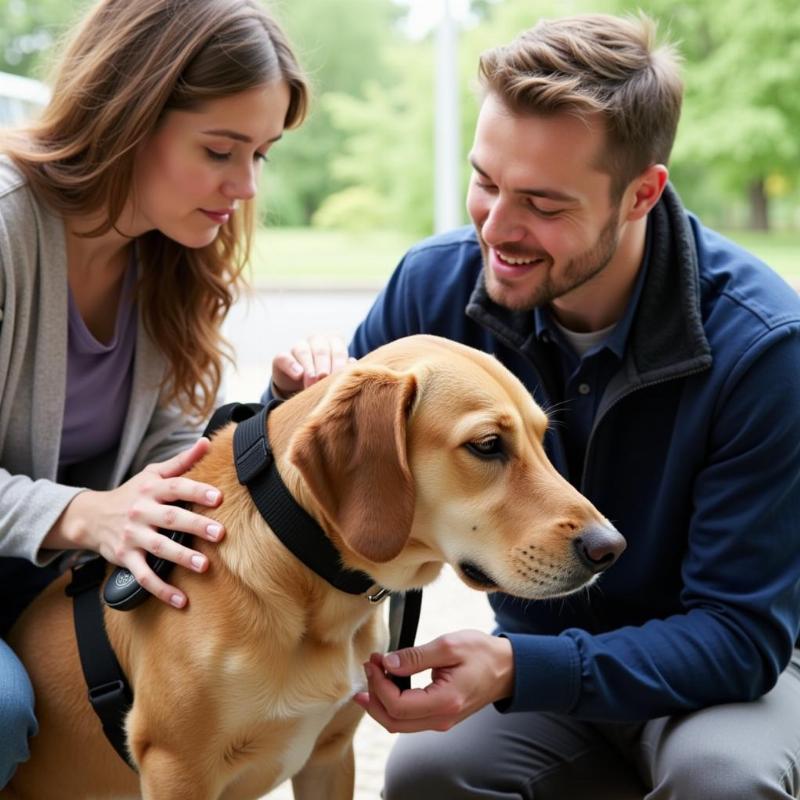Choosing a shock collar for your large dog requires careful consideration. While labeled as “strongest,” the focus should be on finding the most effective and humane option for training and managing your dog’s behavior. This guide navigates the complex world of shock collars, offering crucial insights into safe usage, ethical considerations, and alternatives for responsible pet owners in the US. Remember, your dog’s well-being is paramount.
Understanding Shock Collars and Their Impact on Large Dogs
Shock collars, also known as e-collars or training collars, deliver a static correction intended to interrupt unwanted behavior. For large, powerful breeds, the temptation to opt for the “strongest” collar might seem appealing, but it’s crucial to understand that higher intensity doesn’t necessarily translate to better training outcomes. Overly strong stimulation can cause fear, anxiety, and even physical harm. The goal is to find a collar with adjustable levels of stimulation that allow you to find the lowest effective setting for your dog’s temperament and training needs.
Choosing the Right Shock Collar: Prioritizing Safety and Effectiveness
Not all shock collars are created equal. When choosing a collar for your large dog, consider these essential factors:
- Size and Fit: Ensure the collar fits snugly but comfortably, allowing for two fingers between the collar and your dog’s neck.
- Adjustable Stimulation Levels: Opt for collars with a wide range of stimulation levels, allowing you to start low and gradually increase if needed.
- Safety Features: Look for features like automatic shut-off to prevent over-stimulation and tone-only modes for positive reinforcement.
- Range: Consider the distance you need the collar to function effectively, especially for off-leash training.
- Waterproofing: If your dog enjoys swimming, a waterproof collar is a must.
Responsible Use of Shock Collars: Training Techniques and Ethical Considerations
Using a shock collar responsibly is crucial for your dog’s well-being. Consult with a certified professional dog trainer for guidance on proper usage and training techniques. Avoid using the collar as punishment, and always prioritize positive reinforcement methods alongside the collar. Start with the lowest stimulation level and only increase as needed. Observe your dog’s reactions carefully and adjust your approach accordingly.
 Consulting a Dog Trainer about E-Collar Use
Consulting a Dog Trainer about E-Collar Use
Alternatives to Shock Collars: Exploring Humane Training Options
Many effective and humane alternatives to shock collars exist. Positive reinforcement training using treats, praise, and toys can be highly successful. Harnesses, head halters, and clicker training are also excellent options for managing large dogs without resorting to aversive methods. Consider exploring these alternatives before using a shock collar.
Addressing Common Concerns: Safety, Effectiveness, and Ethical Considerations
Is a shock collar right for your dog? This is a question every responsible owner must ask themselves. While shock collars can be effective tools in certain situations, they are not a quick fix. They require patience, consistency, and a commitment to responsible usage.
Conclusion: Making Informed Decisions for Your Large Dog
Choosing the “strongest” shock collar isn’t the solution. Choosing the right approach is. Prioritize your dog’s well-being by focusing on humane training methods, responsible usage, and exploring alternatives. With careful consideration and guidance from a professional, you can make the best decision for your large dog’s training and behavioral management.
FAQ:
- Is a shock collar cruel for my large dog? While shock collars can be aversive, responsible use under the guidance of a professional can minimize discomfort and maximize effectiveness. Always consider humane alternatives.
- What is the best shock collar for an aggressive large dog? Consult with a certified dog trainer or behaviorist specializing in aggression. They can assess your dog’s specific needs and recommend appropriate training tools and techniques.
- Can I use a shock collar on a puppy? Shock collars are generally not recommended for puppies. Focus on positive reinforcement and socialization during their early developmental stages.
- Are there any legal restrictions on shock collar usage in the US? Regulations vary by state and locality. Research your local laws regarding the use of shock collars.
- How do I find a certified dog trainer in my area? The Certification Council for Professional Dog Trainers (CCPDT) is a reputable resource for finding certified trainers in the US.
- What are the long-term effects of using a shock collar on a dog? Improper or excessive use can lead to behavioral problems, anxiety, and fear. Responsible use, combined with positive reinforcement, is essential to minimize risks.
- Can a shock collar help with recall training? Shock collars can be a tool for recall training, but should be used responsibly and under the guidance of a professional. Positive reinforcement methods are highly recommended for building a strong recall.
Learn More About Responsible Dog Ownership
Explore these related articles on Beautdogs.us:
- [Link to article about positive reinforcement training]
- [Link to article about dog training tools and techniques]
About Beautdogs.us
Beautdogs.us is your trusted source for comprehensive dog care information, breed-specific guidance, and expert advice on pet products. We cater to both novice and experienced dog owners in the US, empowering you to provide the best possible care for your canine companion. We cover everything from breed specifics and training tips to nutrition and health. Let Beautdogs.us be your guide to responsible and informed dog ownership. Contact us at [email protected] or +1 501-555-7529 for personalized advice.